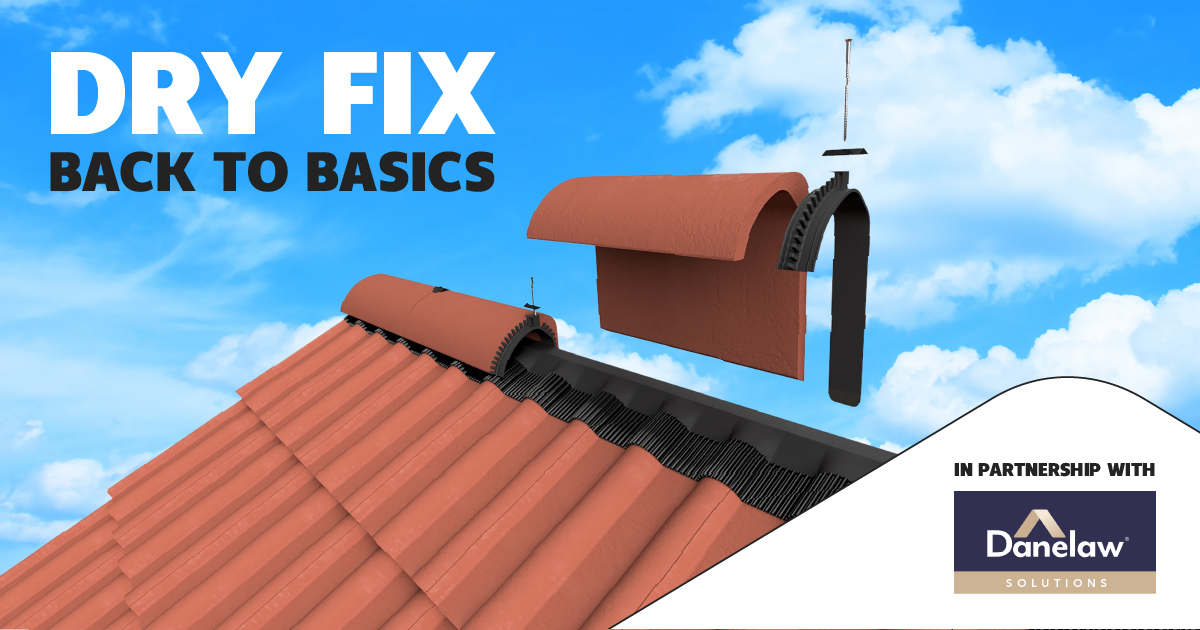Dry Fix Back to Basics - in partnership with Danelaw!
Posted on 17th August 2022
Back to Basics
In the late 2000s, NHBC were one of the key drivers behind the push for mechanical fixing and reduced reliance on mortar for roof works. With more extreme weather, shorter completion times, and improper practices, there was an increase in mortar related issues such as shrinkage, cracking, and additional risk due to falling components.
In 2014, amendments to BS 5534, Slating and tiling for pitched roofs and vertical cladding. Code of practice, deemed that mortar could no longer be relied upon as the only method of securing the roof tile, ridge and hip components. Mechanical fixing was now required. As a result of this, there was an upsurge of dry fix products available that were either poor quality or poorly installed, resulting in issues with completed roofs. The industry called out for something to determine product quality, leading to BS 8612:2018 Dry fixed ridge, hip, and verge systems for slating and tiling specifications.
Hambleside Danelaw were ahead of the game, having first started to develop and promote dry fix solutions in the late 1990s, launching our dry fix valley trough in 1997. It was designed to eliminate the need for mortar, be quicker to install, and less dependent on the weather. With all our dry fix range tested for performance and compliance with the requirements of BS 8612:2018, Hambleside Danelaw are committed to enhancing knowledge in the sector. We have produced this guide to help remind roofers what to expect with dry fix solutions.

These valley troughs are installed to provide hidden water channels at the valley intersections on sloping roofs, allowing for easy water drainage. Hambleside Danelaw manufacture both traditional open and dry fix valley troughs. As an alternative to lead, our original and best patented dry fix valley trough design is made from GRP and has the benefit of being lightweight, durable and easy to handle.
We have dry fix valley trough profiles suitable for flat and plain tile roofs, profiled tile roofs, and slate roofs, all of which are appropriate for a mortarless application and deliver a much neater roofscape as well as a more traditional close mitred appearance predating the use of open water channels formed using lead

Danelaw’s Verg family includes a range of interlocking tile verges that are designed to secure the tiles, prevent water ingress and infestation while removing the need for mortar at the roof edge. Hambleside Danelaw manufacture five different types of interlocking tile verge systems, as well as a continuous slate verge range.
The latest addition to our range, the MidVerg20®, was launched earlier this year, and is designed to suit all flat intermediate gauge single-lap interlocking tile types used at 20 tiles per square metre and for new-build or refurbishment. This followed on from our innovative and patented InVerg®, launched in 2020; a unique and hugely popular system designed to meet the demand for an aesthetically pleasing dry fix solution which is compatible with most machine-made single & double cambered concrete and clay plain tile types.

Bonding Gutters® are used to form a joint between two differing roof coverings to ensure a weather-tight joint, traditionally these were designed by Hambleside Danelaw to accommodate the use of mortar bedding, but in more recent years with the move away from mortar use on roofs tend to be dry fix. Accordingly, Hambleside Danelaw were the first to design and manufacture two types of the original Dry Fix Bonding Gutters®:
A high profile version, with a central upstand of 100mm, which is suitable for use with profiled tiles on one or both sides, as well as typical Scottish circumstances where there might be concrete tiles one side and slates fixed directly to sarking boards on the other.
A low profile Bonding Gutter® with a central upstand of 70mm which is for use with slate, flat interlocking, and plain tiles.
We continue to manufacture the traditional Bonding Gutter® which should be installed in conjunction with mortar bedding.

A key part of our range of dry fix products, our three different types of ventilated hip and ridge kits, the CON6+, the CLAY6+, and the MONO6+, all of which include our universal patented gasket design which was developed to be completely flexible and trimmable for best fit to the ridge and hip tiles.
CON6+ — This ventilated ridge and hip system primarily aimed at the concrete ridge and hip tile market features a membrane with broad corrugated adhesive edge strips, which means the CON6+ fits a greater range of roof pitches and tile types than other comparable systems on the market.
CLAY6+ — The CLAY6+ ventilated dry fix ridge and hip system is similar but packed into a kit suitable for all common clay and is suitable for all common baby ridge tiles, such as those seen on single storey lean-to roofs and bay window tops.
MONO6+ — Designed for mono ridged roofs, the MONO6+ is the most recent addition to our ridge and hip range and can be used with all commonly available mono ridge tile types.
Further Information
Take a look at our technical guidance for dry fix on our website, we also have a dedicated team to help with queries regarding our products, get in touch with them at [email protected].
To further support roofing contractors, this year we launched Hambleside Danelaw Hub where learners can develop their skillset.
Back to Basics
Hambleside Danelaw’s Back to Basics series is devoted to helping contractors and developers with relevant information from broad topics like condensation, to more specific information detailing key products for use on the roof. All previous articles can be found in the news section of our website.
If you need any advice or a quotation, please contact your local branch and speak to a member of our experienced sales team who are here to provide on-the-job advice to support your roofing projects.
Share this post:

